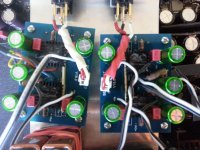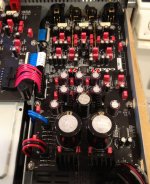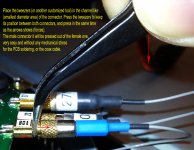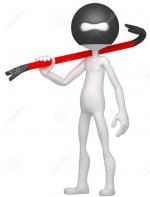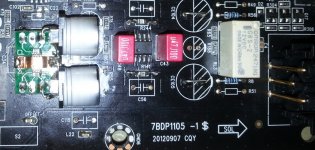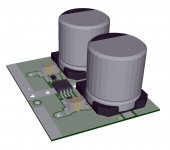Personally, I have found the best approach is to understand what correct reproduction sounds like - which is another way of saying that subjectively disturbing distortion in the playback has been reduced to a level where the mind can easily, and unconsciously ignore it. Trying to get the audio to sound like you think it should, to me is a pointless exercise - it should sound like what is on the recording, whatever that may be. Luckily, what is on the recording, no matter how "bad" it is, is immensely satisfying if it is replayed correctly - you won't get unstuck going to that place!!
I have found most people don't understand "correct" sound, they talk about things like whether behaviour in the midrange is good or not - I just scratch my head with a bemused thought in mind when this talk kicks off; the chances of getting decent sound with this approach is pretty minimal. Many seem to have trained themselves over the years to develop an ever more hifi sounding audio system, which then only sounds decent on highly specialised recordings - the result is something so far from being able to sound correct that it has become a parody ...
We can't take the human condition out of audio - or most things for that matter. People like what they like. Some don't care for "correctness" or their perceptive abilities and preferences differ.
Analog sounding? I wonder what changes that requires to the digital data stream!
So are you saying that these transports are so smart that they can find digital bytes that code for selected signal frequencies and amplitudes from the bit stream coming off the CD; that they then modify those digital words, and then re-insert them at the appropriate place back into the bit stream, then modify the related error correction data to prevent the drive to flag the modified digital words as errors, all on the fly?
Wow! That's not CD drive, that's a super computer with one heck of a piece of software!
Jan
I am not sure what exactly happens, and for the first time in my life I am learning not to really try to explain it by having to measure and prove to myself the benefits (or is it the side-effects??) I can clearly hear. I was scared that the obtained measurements would be much worse compared to what I expected to see, what I learned to expect to see, and what you are telling me I must see, which in turn could force me to convince myself that the sound was really bad, where in fact it was really good judged solely by my ears and emotions I felt when I listen to the Audiomeca. I call that an Analog Sounding CD transport, as opposed to a Digital Sounding. The truth is that those transports sounded so good to everyone who heard them. They are still an object of desire to many high enders who can't get them anymore because they are not in current production.
So if that is true, how come that they and others like you, after years and years of mods, demonstrate they still don't know s**t??
Jan
I remember Jan who was once understanding of other people who needed guidance. This thread is hugely successful; a lot of information is unconditionally shared. As the result, many people felt true benefits of what was shown, and appreciated suggestions and guidance that was provided. They heard the difference in how their 105’s sounded, and they liked it. You had an opportunity to chip-in and provide your expertise towards greater benefit. Maybe your sense of worth comes from being compared to others; to win means to beat, and judging by what you wrote above – to humiliate as well.
Nick
Of course. With regard to live sound, there would be many people who find being near to, say, a live opera singer, or drum kit in full flight an unpleasant, disturbing experience - personally, I find such moments exhilarating ... and that's the sort of sound that the microphones pick up. Reproducing that recorded intensity I believe should be the primary goal, it is being "correct" to the recording - if one wishes to filter or dilute that sound, to suit personal preferences, that's fine, perfectly reasonable - but if the playback device can't reproduce accurately then one's options of how much one can "moderate" the sound, to suit, will be limited ...We can't take the human condition out of audio - or most things for that matter. People like what they like. Some don't care for "correctness" or their perceptive abilities and preferences differ.
All audio equipment when operating can indirectly affect other components, and digital gear can be particularly bad citizens - they generate electrical inteference which winds up affecting, distorting the analogue audio - it's relatively easy to do experiments, where a little bit of electrical nastiness is deliberately generated near a working audio system, and hear the quality degrade. Well behaved, well engineered components are obviously the ones to go for to minimise this - but no typical spec's will ever tell you this sort of thing ...I am not sure what exactly happens, and for the first time in my life I am learning not to really try to explain it by having to measure and prove to myself the benefits (or is it the side-effects??) I can clearly hear.
'vacuphile'
Please submit even 1 measurement from John Atkinson's Stereophile reviews that tell you how an audio product sounds.
Of course you will need to be objective with your proof.
(Note: this is not an implied, or otherwise, criticism of John Atkinson).
Meanwhile, back to your 1983 perfect digital device.
Coris: ignore the nay sayers, they have contributed sweet bugger all.
Please submit even 1 measurement from John Atkinson's Stereophile reviews that tell you how an audio product sounds.
Of course you will need to be objective with your proof.
(Note: this is not an implied, or otherwise, criticism of John Atkinson).
Meanwhile, back to your 1983 perfect digital device.
Coris: ignore the nay sayers, they have contributed sweet bugger all.
Hello,
I'm also a tweaker...
To be honest, before starting tweaking the 105D I have, I think also that Engineers are built a very good product, and probably more clever than me...
So I can't improve it...
BIG MISTAKE !
Engineer have commercial and budget limitations and restrictions in term of cost...
So they cannot build the Graal Bluray Player in these conditions.
Why do you think a lot of company use the OPPO as base and perform a lot of modifications... e.g. Audiocom, Jenalabs, Vinculum, ...
Simple it's an easy upgradable player.
But it has a cost...
All is NOT a measurement question... we cannot proof everything with measurement... it's just a scientific point of view... not the reality neither the Audiophil point of view...
How can you measure Love and Emotions ? 😀
I met a lot of skeptics... and I don't want to spend more time to convince them... I have better things to do ... Tweaks ! 🙄
But before making an opinion or jugement, try to go and listen a OPPO tweaked... and after and only after you could do it !
Coris, continue your researchs... I follow you in the Clock way...
I have to provide you information you request me... I will do it this week normally.
Tomorrow, I will meet a french tweaker in my home, and we will compare the tweak he did on his 103D and my 105D, also with a 103D out of the box...
A friend of mine, will be also present to avoid emotional side and be objective... 😉
It will be a nice evening in perspective...
I'm also a tweaker...
To be honest, before starting tweaking the 105D I have, I think also that Engineers are built a very good product, and probably more clever than me...
So I can't improve it...
BIG MISTAKE !
Engineer have commercial and budget limitations and restrictions in term of cost...
So they cannot build the Graal Bluray Player in these conditions.
Why do you think a lot of company use the OPPO as base and perform a lot of modifications... e.g. Audiocom, Jenalabs, Vinculum, ...
Simple it's an easy upgradable player.
But it has a cost...
All is NOT a measurement question... we cannot proof everything with measurement... it's just a scientific point of view... not the reality neither the Audiophil point of view...
How can you measure Love and Emotions ? 😀
I met a lot of skeptics... and I don't want to spend more time to convince them... I have better things to do ... Tweaks ! 🙄
But before making an opinion or jugement, try to go and listen a OPPO tweaked... and after and only after you could do it !
Coris, continue your researchs... I follow you in the Clock way...
I have to provide you information you request me... I will do it this week normally.
Tomorrow, I will meet a french tweaker in my home, and we will compare the tweak he did on his 103D and my 105D, also with a 103D out of the box...
A friend of mine, will be also present to avoid emotional side and be objective... 😉
It will be a nice evening in perspective...

Oppo with SEN I/V
Having some fun with the SEN I/V in the Oppo.
The images show the test run to make sure it works and sounds good and it does.
Permanent power supply now to be investigated...
The info about SEN can be found here:
http://www.diyaudio.com/forums/digital-source/195483-zen-cen-sen-evolution-minimalistic-iv-converter.html
More mods to come
Having some fun with the SEN I/V in the Oppo.
The images show the test run to make sure it works and sounds good and it does.
Permanent power supply now to be investigated...
The info about SEN can be found here:
http://www.diyaudio.com/forums/digital-source/195483-zen-cen-sen-evolution-minimalistic-iv-converter.html
More mods to come
Attachments
Nice work, we're curious to hear your before and after comparison of the sound.🙂Having some fun with the SEN I/V in the Oppo.
The images show the test run to make sure it works and sounds good and it does.
Permanent power supply now to be investigated...
You can find the AAA tabbed NIMH rechargeable batteries online for less than a dollar apiece.
Erichttp://www.batteryspace.com/aaasizeseriesbatteries.aspx
Only worth it if the batteries have the lifecycle simlar to the Endloops... seem to be the best.
PM me the link if you have it.
Will try to do some more careful listening and comment later, but first impressions;
I still have the stock balanced I/V output for comparison although not level matched, but I gotta say it sounds very open/dynamic and more spatially expressive (soundstage)
Complex passages do not get messy and is seems easier to follow individual instruments.
There are still upgrades/treaks to be done to the SEN before it of finally installed.
PM me the link if you have it.
Will try to do some more careful listening and comment later, but first impressions;
I still have the stock balanced I/V output for comparison although not level matched, but I gotta say it sounds very open/dynamic and more spatially expressive (soundstage)
Complex passages do not get messy and is seems easier to follow individual instruments.
There are still upgrades/treaks to be done to the SEN before it of finally installed.
Last edited:
Does anyone replace the stock XLR socket with Neutrik or furutech?
How much improvement did you get?
Thanks
How much improvement did you get?
Thanks
😡I just find out that the "SILMIC" caps used for AC coupling on the 105 boards are a Elna type ones...
I'm quite late to this topic, but after observe the picture of the stereo output board I was quite disappointing with capacitors type at the PSU rail near the active parts: TK??!! WTF are those caps??😱
For PCB "dimension issues" with caps just take a ride with Nichicon Fine Gold series...
And what about the opamps used at the output stage; what model/brand??
😛
Forget it, I just read the 105 use LM4562. A bit mid bright to my taste. An OPA1612 or AD826 can sound more balanced, as many others that I don't listen yet. Be aware of BIAS current in OPAMPS... to avoid abnormal DC offset at output stage.
For my point of view its a very upgradable player at output stage.

Last edited:
List of analog upgrade
I compile of list of the upgrades for the analog section.
If anyone can recommend a better one please let me know. These are based on stock diameter caps
XLR caps x 4: DIAMETER 10mm:
Havent found a better one
220 uf 25v x 30 DIAMETER 6MM
P12383-ND FM SERIES 220µF 25V Dia (8.00mm) ( a bit too big)
P12920-ND FM Series 220µF 10V Dia (6.30mm) (has lower volt)
6800uf 35v x 2: DIAMETER 28MM:
MUNDORF-71838 6800µF / 63VDC, MLytic® Audio Grade 30 * 40 OR
P12351-ND FM SERIES 6800µF 6.3V Dia (16.00mm) (lower V)
3300 50v x 1 diameter 16mm:
P12373-ND 3300µF 16V FM Series Dia (12.50mm)
1000uf 25v x 8 diameter 12MM P12379-ND FM SERIES 1000µF 25V Dia (12.50mm)
L4562/L49754 replace by AD 826
LM 2990T/2940 replace by
15v Dexa UWB " Series" Regulator (Positive) (78xx Series) and
-15.0v Dexa UWB "Series" Regulator (Negative) (79xx Series)
Scotty barrier 150V x 8
Replace XLR socket
These are my list. I am new to MOD so don't really know what best. Can someone please fix it?
Thanks,
Dan
I compile of list of the upgrades for the analog section.
If anyone can recommend a better one please let me know. These are based on stock diameter caps
XLR caps x 4: DIAMETER 10mm:
Havent found a better one
220 uf 25v x 30 DIAMETER 6MM
P12383-ND FM SERIES 220µF 25V Dia (8.00mm) ( a bit too big)
P12920-ND FM Series 220µF 10V Dia (6.30mm) (has lower volt)
6800uf 35v x 2: DIAMETER 28MM:
MUNDORF-71838 6800µF / 63VDC, MLytic® Audio Grade 30 * 40 OR
P12351-ND FM SERIES 6800µF 6.3V Dia (16.00mm) (lower V)
3300 50v x 1 diameter 16mm:
P12373-ND 3300µF 16V FM Series Dia (12.50mm)
1000uf 25v x 8 diameter 12MM P12379-ND FM SERIES 1000µF 25V Dia (12.50mm)
L4562/L49754 replace by AD 826
LM 2990T/2940 replace by
15v Dexa UWB " Series" Regulator (Positive) (78xx Series) and
-15.0v Dexa UWB "Series" Regulator (Negative) (79xx Series)
Scotty barrier 150V x 8
Replace XLR socket
These are my list. I am new to MOD so don't really know what best. Can someone please fix it?
Thanks,
Dan
Hi PhopsonNY,
I am new to mod, are these refers to the 4 caps near the xlr output? please point me in the right direction. Thanks
I am new to mod, are these refers to the 4 caps near the xlr output? please point me in the right direction. Thanks
Hi Coris,
Really good work on the clock...
Wrt the preDAC caps, I ended up installing 4 Nichicon CG Aluminum Organic Polymer Capacitors 6.3V 2700uF for the higher capacitance as suggested...
These are SMD types and larger than the original caps so installation had to be creative. I chose them over the Nichcon HZ due to their lower esr and higher ripple current.
After 2 days burn in, they have added another level of richness to the sound of the sound. Instruments sound more complete now and the continuity between the base lines and the higher registers is smoother.
Thanks for the suggestion... very worth while.
Sanstodx5 - DAC caps
No...
We were talking to about the caps that stabilize the DAC voltage
By the way, I would increase the size of your Mundorf caps to 10000
No...
We were talking to about the caps that stabilize the DAC voltage
By the way, I would increase the size of your Mundorf caps to 10000
Hi PhopsonNY,
I am new to mod, are these refers to the 4 caps near the xlr output? please point me in the right direction. Thanks
Attachments
My battery powered clock board (with divided 216Mhz SAW oscillator, or in another configuration) it may be available for those interested.
Best of all if you may send in your analogue board (105/105D models) for installation of the clock board, and/or for other available modifications.
Please PM me for more details.
Best of all if you may send in your analogue board (105/105D models) for installation of the clock board, and/or for other available modifications.
Please PM me for more details.
Recently I have experimented with OPA1632 as I/V for balanced outputs. Very good results! I have used the MSOP (with thermal pad) version of this chip.
The balanced outputs stages use the same opamp configuration (around opamp chip) for both I/V and final buffer. So, it came up the idea to have a standard module which it can be used to replace the opamps for balanced outputs in original design. Even more, such (standard) module it can be used to replace the original I/V stage for unbalanced channels too.
I have just designed the small PCB and send it to production. My module it will have two versions, for MSOP and SOIC packages, and will be available complete equipped and tested, or as a bare board for own customized configurations. The module it will perfect fit the foot prints (through holes) on the original board, and it will use the power lines available around the opamp chip on the player stereo board. It is meant to be mounted using very short bare wires as terminals which are to be placed in the holes for feedback resistors and decoupling caps in original design. The whole original/old components (opmps, and its around resistors/caps) have to be removed to make possible the properly functioning of this module. I will come back with more details and pictures, when the finished module it will be assembled and mounted in place.
The pictures here shows the prototype module (mounted on a MSOP adapter board, and the 3D model of my already designed module.
The balanced outputs stages use the same opamp configuration (around opamp chip) for both I/V and final buffer. So, it came up the idea to have a standard module which it can be used to replace the opamps for balanced outputs in original design. Even more, such (standard) module it can be used to replace the original I/V stage for unbalanced channels too.
I have just designed the small PCB and send it to production. My module it will have two versions, for MSOP and SOIC packages, and will be available complete equipped and tested, or as a bare board for own customized configurations. The module it will perfect fit the foot prints (through holes) on the original board, and it will use the power lines available around the opamp chip on the player stereo board. It is meant to be mounted using very short bare wires as terminals which are to be placed in the holes for feedback resistors and decoupling caps in original design. The whole original/old components (opmps, and its around resistors/caps) have to be removed to make possible the properly functioning of this module. I will come back with more details and pictures, when the finished module it will be assembled and mounted in place.
The pictures here shows the prototype module (mounted on a MSOP adapter board, and the 3D model of my already designed module.
Attachments
Last edited:
My battery powered clock board (with divided 216Mhz SAW oscillator.
Hi Coris, which chip did you end up as the divider by four? Cheers, Joe
.
- Home
- Source & Line
- Digital Source
- Oppo's BDP105 - discussions, upgrading, mods...

